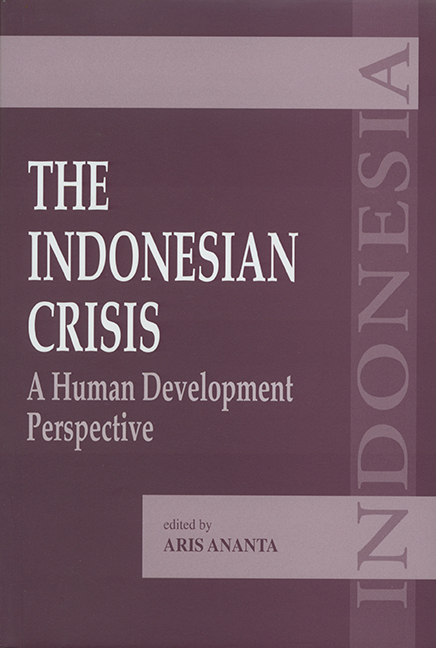Book contents
- Frontmatter
- Contents
- Acknowledgements
- List of Contributors
- Part I Introduction
- 1 What Do We Learn from the Crisis? Insights on Human Development in Indonesia during 1997–99
- 2 Macroeconomic Recovery: Facts and Prospects
- 3 Indonesia's Economic Transformation: Before and During the Economic Crisis
- 4 Modelling the Repercussions of Financial Shock on Socio-economic Indicators
- Part II Human Capital
- Part III Purchasing Power
- Part IV Emerging Issues
- Index
2 - Macroeconomic Recovery: Facts and Prospects
from Part I - Introduction
Published online by Cambridge University Press: 21 October 2015
- Frontmatter
- Contents
- Acknowledgements
- List of Contributors
- Part I Introduction
- 1 What Do We Learn from the Crisis? Insights on Human Development in Indonesia during 1997–99
- 2 Macroeconomic Recovery: Facts and Prospects
- 3 Indonesia's Economic Transformation: Before and During the Economic Crisis
- 4 Modelling the Repercussions of Financial Shock on Socio-economic Indicators
- Part II Human Capital
- Part III Purchasing Power
- Part IV Emerging Issues
- Index
Summary
Is Recovery Sustainable?
The widely-held perception is that the economy has not improved. Yet, it may not be entirely true. If political headlines are used as proxy to the economy, this perception holds. In politics, as if the antagonism between President Wahid and the DPR (Parliament) is not enough, regional tensions (in Aceh, Maluku, Kalimantan, and West Timor), bomb explosions, and political scandals have made the rupiah a yo-yo currency, increasing the financial market's risk and driving inflation and interest rates upward. However, contradictory trends have dominated Indonesia since 1999 when signs of a continued recovery in the economy was seen amidst turbulent politics. Non-performing loans (NPLs) in banks, although still high, came down to 19 per cent in April 2001 from 27 per cent in September 2000, signalling an improvement on the economic front. We get a better picture if we use consumption or exports as a proxy to the economy. Trade figures have improved quite markedly; the industrial production index has shown improvement; there is a relatively high volume of vehicle sales — all these indicate improvements in the real economy.
This chapter aims to address two basic questions: has the economy really improved? If so, is the improvement sustainable (at least in the mid-term)? It first describes the depth of the crisis. Next it discusses the improving macro picture of the Indonesian economy before exploring whether the recovery will sustain.
The Depth of the Crisis: The 1998 Stories
The Worst in Indonesia's Modern History
At the outset of the crisis, the economy deteriorated faster than expected. Unable to withstand the shock, the financial sector contracted. The real sector was also severely hit and, as a result, the financial sector destabilized even further. In 1998, Indonesia's gross domestic product (GDP) growth dropped by 18 percentage points to –13.1 per cent. The massive cost of the bail-out (more than half of GDP), the amount of output being squeezed (Indonesia's 1998 real GDP equal that of 1995), the number of people being sent back to below the poverty line (as at December 1998, based on a BPS estimate, some 15 million people moved back into poverty), and the systemic nature of the crisis across the financial and the real sectors have plunged Indonesia into the worst economic crisis in its modern history.
- Type
- Chapter
- Information
- The Indonesian CrisisA Human Development Perspective, pp. 29 - 52Publisher: ISEAS–Yusof Ishak InstitutePrint publication year: 2002



